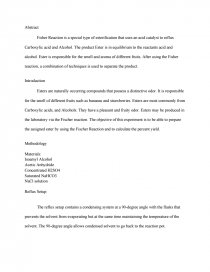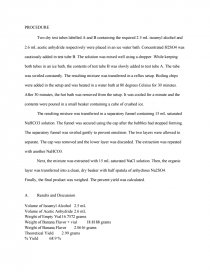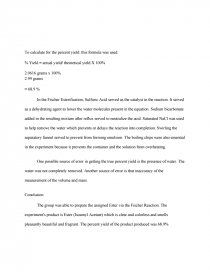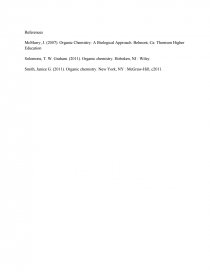Fisher Reaction
Essay by people • August 31, 2011 • Case Study • 659 Words (3 Pages) • 2,208 Views
Abstract
Fisher Reaction is a special type of esterification that uses an acid catalyst to reflux Carboxylic acid and Alcohol. The product Ester is in equilibrium to the reactants acid and alcohol. Ester is responsible for the smell and aroma of different fruits. After using the Fisher reaction, a combination of techniques is used to separate the product.
Introduction
Esters are naturally occurring compounds that possess a distinctive odor. It is responsible for the smell of different fruits such as bananas and strawberries. Esters are most commonly from Carboxylic acids, and Alcohols. They have a pleasant and fruity odor. Esters may be produced in the laboratory via the Fischer reaction. The objective of this experiment is to be able to prepare the assigned ester by using the Fischer Reaction and to calculate the percent yield.
Methodology
Materials:
Isoamyl Alcohol
Acetic Anhydride
Concentrated H2SO4
Saturated NaHCO3
NaCl solution
Reflux Setup:
The reflux setup contains a condensing system at a 90-degree angle with the flasks that prevents the solvent from evaporating but at the same time maintaining the temperature of the solvent. The 90-degree angle allows condensed solvent to go back to the reaction pot.
PROCEDURE
Two dry test tubes labelled A and B containing the required 2.5 mL isoamyl alcohol and 2.6 mL acetic anhydride respectively were placed in an ice water bath. Concentrated H2SO4 was cautiously added in test tube B. The solution was mixed well using a dropper. While keeping both tubes in an ice bath, the contents of test tube B was slowly added to test tube A. The tube was swirled constantly. The resulting mixture was transferred in a reflux setup. Boiling chips were added in the setup and was heated in a water bath at 80 degrees Celsius for 30 minutes. After 30 minutes, the hot bath was removed from the setup. It was cooled for a minute and the contents were poured in a small beaker containing a cube of crushed ice.
The resulting mixture was transferred in a separatory funnel containing 15 mL saturated NaHCO3 solution. The funnel was secured using the cap after the bubbles had stopped forming. The separatory funnel was swirled gently to prevent emulsion. The two layers were allowed to separate. The cap was removed and the lower layer was discarded. The extraction was repeated with another NaHCO3.
Next,
...
...



